| Listing 1 - 9 of 9 |
Sort by
|
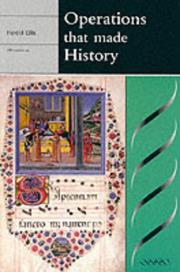
ISBN: 0511043449 9780511043444 0585220662 9780585220666 1900151154 Year: 1996 Publisher: London Greenwich Medical Media
Abstract | Keywords | Export | Availability | Bookmark
 Loading...
Loading...Choose an application
- Reference Manager
- EndNote
- RefWorks (Direct export to RefWorks)
Surgery --- Surgery, Operative --- General Surgery --- Famous Persons. --- Surgical Procedures, Operative --- Famous Person --- Persons, Famous --- Operative surgery --- Surgical techniques --- History --- history. --- methods. --- Technique --- History.
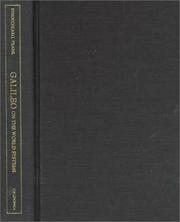
ISBN: 1282355015 9786612355011 0520918223 058505519X 9780520918221 9780585055190 0520205480 0520206460 9781282355019 Year: 1997 Publisher: Berkeley University of California Press
Abstract | Keywords | Export | Availability | Bookmark
 Loading...
Loading...Choose an application
- Reference Manager
- EndNote
- RefWorks (Direct export to RefWorks)
Galileo's 1632 book, Dialogue on the Two Chief World Systems, Ptolemaic and Copernican, comes alive for twentieth-century readers thanks to Maurice Finocchiaro's brilliant new translation and presentation. Condemned by the Inquisition for its heretical proposition that the earth revolves around the sun, Galileo's masterpiece takes the form of a debate, divided into four "days," among three highly articulate gentlemen. Finocchiaro sets the stage with his introduction, which not only provides the human and historical framework for the Dialogue but also admits the reader gracefully into the basic non-Copernican understanding of the universe that would have been shared by Galileo's original audience. The translation of the Dialogue is abridged in order to highlight its essential content, and Finocchiaro gives titles to the various parts of the debate as a guide to the principal topics. By explicating his own critical reading of this text that is itself an exercise in critical reasoning on a gripping real-life controversy, he illuminates those universal, perennial activities of the human mind that make Galileo's book a living document. This is a concrete, hands-on introduction to critical thinking. The translation has been made from the Italian text provided in volume 7 of the Critical National Edition of Galileo's complete works edited by Antonio Favaro. The translator has also consulted the 1632 edition, as well as the other previous English translations, including California's 1967 version.Galileo on the World Systems is a remarkably nuanced interpretation of a classic work and will give readers the tools to understand and evaluate for themselves one of the most influential scientific books in Western civilization.
Astronomy --- Galilei, Galileo, --- Solar system --- Early works to 1800. --- Galilei, Galileo --- Early works to 1800 --- ancient world. --- astronomer. --- astronomy. --- biographical. --- copernican. --- copernicus. --- critical thinking. --- cultural context. --- famous person. --- hands on. --- historical context. --- italian history. --- italy. --- literary analysis. --- literary criticism. --- literary studies. --- outer space. --- philosopher. --- philosophy. --- planets. --- ptolemaic. --- ptolemy. --- scientific. --- solar system. --- translation. --- universe. --- western world. --- world history. --- world systems.
Book
ISBN: 022617154X 9780226171548 9780226171371 9780226171401 022617137X Year: 2014 Publisher: Chicago London The University of Chicago Press
Abstract | Keywords | Export | Availability | Bookmark
 Loading...
Loading...Choose an application
- Reference Manager
- EndNote
- RefWorks (Direct export to RefWorks)
George Herbert Mead is a foundational figure in sociology, best known for his book Mind, Self, and Society, which was put together after his death from course notes taken by stenographers and students and from unpublished manuscripts. Mead, however, never taught a course primarily housed in a sociology department, and he wrote about a wide variety of topics far outside of the concerns for which he is predominantly remembered-including experimental and comparative psychology, the history of science, and relativity theory. In short, he is known in a discipline in which he did not teach for a book he did not write. In Becoming Mead, Daniel R. Huebner traces the ways in which knowledge has been produced by and about the famed American philosopher. Instead of treating Mead's problematic reputation as a separate topic of study from his intellectual biography, Huebner considers both biography and reputation as social processes of knowledge production. He uses Mead as a case study and provides fresh new answers to critical questions in the social sciences, such as how authors come to be considered canonical in particular disciplines, how academics understand and use others' works in their research, and how claims to authority and knowledge are made in scholarship. Becoming Mead provides a novel take on the history of sociology, placing it in critical dialogue with cultural sociology and the sociology of knowledge and intellectuals.
Sociology --- Methodology. --- Mead, George Herbert, --- Mead, G. H. --- Sociology - Methodology --- academic, learning, scholarly, research, college, university, sociology, psychology, psychologist, posthumous, experimental, comparative, science, relativity, scientific, disciplines, interdisciplinary, knowledge, philosophy, philosopher, reputation, controversial, intellectual, thinker, famous person, case study, social studies, academics, critical, laboratory, methodology, classroom, student.
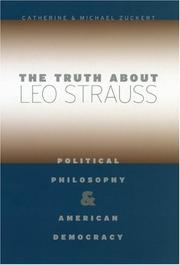
ISBN: 1281966916 9786611966911 0226993345 9780226993348 9780226993324 0226993337 0226993329 9780226993331 9781281966919 6611966919 Year: 2006 Publisher: Chicago University of Chicago Press
Abstract | Keywords | Export | Availability | Bookmark
 Loading...
Loading...Choose an application
- Reference Manager
- EndNote
- RefWorks (Direct export to RefWorks)
Is Leo Strauss truly an intellectual forebear of neoconservatism and a powerful force in shaping Bush administration foreign policy? The Truth about Leo Strauss puts this question to rest, revealing for the first time how the popular media came to perpetuate such an oversimplified view of such a complex and wide-ranging philosopher. More important, it corrects our perception of Strauss, providing the best general introduction available to the political thought of this misunderstood figure. Catherine and Michael Zuckert-both former students of Strauss-guide readers
Political science --- Philosophy. --- History. --- Strauss, Leo. --- famous person, history, historical, well known, philosopher, philosophy, politics, political, america, american, democracy, government, poli sci, neoconservatism, conservative, bush, administration, foreign policy, media, misunderstood, myth, analysis, explanation, ancient, modern, nihilism, relativism, strength, weakness, heidegger, nietzsche, contemporary, crisis, postmodern, republic.
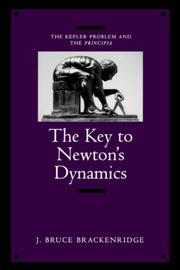
ISBN: 1282355007 9786612355004 0520916859 0585375828 9780520916852 0520200659 9780520200654 0520202171 9780520202177 9781282355002 9780585375823 Year: 1995 Publisher: Berkeley University of California Press
Abstract | Keywords | Export | Availability | Bookmark
 Loading...
Loading...Choose an application
- Reference Manager
- EndNote
- RefWorks (Direct export to RefWorks)
While much has been written on the ramifications of Newton's dynamics, until now the details of Newton's solution were available only to the physics expert. The Key to Newton's Dynamics clearly explains the surprisingly simple analytical structure that underlies the determination of the force necessary to maintain ideal planetary motion. J. Bruce Brackenridge sets the problem in historical and conceptual perspective, showing the physicist's debt to the works of both Descartes and Galileo. He tracks Newton's work on the Kepler problem from its early stages at Cambridge before 1669, through the revival of his interest ten years later, to its fruition in the first three sections of the first edition of the Principia.
Kepler's laws. --- Celestial mechanics. --- Gravitational astronomy --- Mechanics, Celestial --- Kepler laws --- Kepler's laws of planetary motion --- Planetary motion, Kepler's laws of --- Astrophysics --- Mechanics --- Planetary theory --- Planets --- Orbits --- Celestial mechanics --- Kepler's laws --- Astronomy --- Newton, Isaac --- 1600s. --- academic. --- analysis. --- biographical. --- cambridge. --- centrifugal force. --- conservation of motion. --- cultural context. --- curvature. --- descartes. --- famous person. --- famous scientist. --- galileo. --- historical. --- history buff. --- kepler problem. --- laws of motion. --- mathematics. --- newton. --- newtons dynamics. --- outer space. --- physics. --- planetary motion. --- planets. --- principia. --- scholarly. --- scientific. --- scientist. --- true story.
Book
ISBN: 9780226040028 9780226040165 022604016X 022604002X Year: 2013 Publisher: Chicago The University of Chicago Press
Abstract | Keywords | Export | Availability | Bookmark
 Loading...
Loading...Choose an application
- Reference Manager
- EndNote
- RefWorks (Direct export to RefWorks)
Despite its foundational role in the history of philosophy, Plato's famous argument that art does not have access to truth or knowledge is now rarely examined, in part because recent philosophers have assumed that Plato's challenge was resolved long ago. In Art and Truth after Plato, Tom Rockmore argues that Plato has in fact never been satisfactorily answered-and to demonstrate that, he offers a comprehensive account of Plato's influence through nearly the whole history of Western aesthetics. Rockmore offers a cogent reading of the post-Platonic aesthetic tradition as a series of responses to Plato's position, examining a stunning diversity of thinkers and ideas. He visits Aristotle's Poetics, the medieval Christians, Kant's Critique of Judgment, Hegel's phenomenology, Marxism, social realism, Heidegger, and many other works and thinkers, ending with a powerful synthesis that lands on four central aesthetic arguments that philosophers have debated. More than a mere history of aesthetics, Art and Truth after Plato presents a fresh look at an ancient question, bringing it into contemporary relief.
Philosophy --- Aesthetics of art --- Aesthetics --- Art --- Imitation in art --- Mimesis in art --- Truthfulness and falsehood in art --- Pictures --- Appropriation (Art) --- Beautiful, The --- Beauty --- Art and philosophy --- Esthetics --- Taste (Aesthetics) --- Criticism --- Literature --- Proportion --- Symmetry --- Reproduction --- Copying --- Analysis, interpretation, appreciation --- Psychology --- Mimesis in art. --- Imitation in art. --- Truthfulness and falsehood in art. --- Aesthetics. --- Philosophy. --- Radio broadcasting Aesthetics --- philosophy, philosopher, famous person, well known, ancient, history, historical, argument, knowledge, artistic, answer, question, aesthetics, western, academic, scholarly, research, platonic, diverse, thinker, intellect, aristotle, poetics, medieval, christian, kant, critique, judgment, hegel, phenomenology, marxism, social realism, heidegger, falsehood, limits.
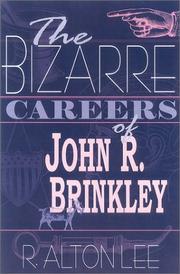
ISBN: 0813158656 0813170370 9780813170374 9780813158655 0813122325 9780813122328 081319539X 0813197422 9780813197425 9780813195391 Year: 2002 Publisher: Lexington, Ky. University Press of Kentucky
Abstract | Keywords | Export | Availability | Bookmark
 Loading...
Loading...Choose an application
- Reference Manager
- EndNote
- RefWorks (Direct export to RefWorks)
Tells the story of the infamous ""Goat Gland Doctor"" -- controversial medical charlatan, groundbreaking radio impresario, and prescient political campaigner -- and recounts his amazing rags to riches to rags career. A popular joke of the 1920s posed the question, ""What's the fastest thing on four legs?"" The punch line? ""A goat passing Dr. Brinkley's hospital!""It seems that John R. Brinkley's virility rejuvenation cure -- transplanting goat gonads into aging men -- had taken the nation by storm. Never mind that ""Doc"" Brinkley's medical credentials were shaky at best and that he prescribe
History of Medicine, 20th Cent. --- Quackery --- Famous Persons --- Radio broadcasters --- Quacks and quackery --- Charlatans --- Impostors and imposture --- Medicine --- Swindlers and swindling --- Broadcasters --- Radio personalities --- Famous Person --- Persons, Famous --- Quackeries --- Fraud --- Deception --- Nostrums --- 20th Cent. History (Medicine) --- 20th Cent. History of Medicine --- 20th Cent. Medicine --- Historical Events, 20th Century --- History, Twentieth Century --- Medical History, 20th Cent. --- Medicine, 20th Cent. --- 20th Century History --- 20th Cent. Histories (Medicine) --- 20th Century Histories --- Cent. Histories, 20th (Medicine) --- Cent. History, 20th (Medicine) --- Century Histories, 20th --- Century Histories, Twentieth --- Century History, 20th --- Century History, Twentieth --- Histories, 20th Cent. (Medicine) --- Histories, 20th Century --- Histories, Twentieth Century --- History, 20th Cent. (Medicine) --- Twentieth Century Histories --- Twentieth Century History --- history --- Brinkley, John Richard, --- Brinkley, J. R. --- History, 20th Century --- United States
Book
ISBN: 022606591X 9780226065915 9780226065885 022606588X 022671764X Year: 2014 Publisher: Chicago, Illinois
Abstract | Keywords | Export | Availability | Bookmark
 Loading...
Loading...Choose an application
- Reference Manager
- EndNote
- RefWorks (Direct export to RefWorks)
Although Hegel considered Science of Logic essential to his philosophy, it has received scant commentary compared with the other three books he published in his lifetime. Here philosopher Stanley Rosen rescues the Science of Logic from obscurity, arguing that its neglect is responsible for contemporary philosophy's fracture into many different and opposed schools of thought. Through deep and careful analysis, Rosen sheds new light on the precise problems that animate Hegel's overlooked book and their tremendous significance to philosophical conceptions of logic and reason. Rosen's overarching question is how, if at all, rationalism can overcome the split between monism and dualism. Monism-which claims a singular essence for all things-ultimately leads to nihilism, while dualism, which claims multiple, irreducible essences, leads to what Rosen calls "the endless chatter of the history of philosophy." The Science of Logic, he argues, is the fundamental text to offer a new conception of rationalism that might overcome this philosophical split. Leading readers through Hegel's book from beginning to end, Rosen's argument culminates in a masterful chapter on the Idea in Hegel. By fully appreciating theScience of Logic and situating it properly within Hegel's oeuvre, Rosen in turn provides new tools for wrangling with the conceptual puzzles that have brought so many other philosophers to disaster.
Logic. --- Philosophy. --- Mental philosophy --- Humanities --- Argumentation --- Deduction (Logic) --- Deductive logic --- Dialectic (Logic) --- Logic, Deductive --- Intellect --- Philosophy --- Psychology --- Science --- Reasoning --- Thought and thinking --- Methodology --- Hegel, Georg Wilhelm Friedrich, --- Hegel, Giorgio Guglielmo Frederico --- Hegel, Georg Wilhelm Friedrich --- Hēgeru, --- Hei-ko-erh, --- Gegelʹ, Georg, --- Hījil, --- Khegel, --- Hegel, G. W. F. --- Hegel, --- Hei Ge Er, --- Chenkel, --- Hīghil, --- הגל, --- הגל, גאורג וילהלם פרידריך, --- הגל, גיאורג וילהלם פרידריך, --- הגל, ג.ו.פ, --- היגל, גורג ווילהלם פרדריך, --- היגל, גיורג וילהלם פרידריך, --- 黑格尔, --- Hegel, Guillermo Federico, --- Hegel, Jorge Guillermo Federico, --- Heyel, Georg Wilhelm Friedrich, --- Higil, Gʼūrg Vīlhim Frīdrīsh, --- هگل, --- هگل، گئورگ ويلهم فريدريش, --- logical, logic, theory, theoretical, famous person, well known, philosophy, philosopher, philosophical, commentary, obscure, unknown, thought, thinker, intellect, intellectual, reasoning, reason, academic, scholarly, research, analysis, analytical, rationalism, monism, dualism, concepts, college, university, educational, higher ed, existence, fichtean, objectivity, sentiment.

ISBN: 0393705099 9780393705096 0393700232 039370002X 9780393700022 9780393700237 0317379496 9780317379495 0393702944 9780393702941 0393702839 Year: 2008 Publisher: Norton
Abstract | Keywords | Export | Availability | Bookmark
 Loading...
Loading...Choose an application
- Reference Manager
- EndNote
- RefWorks (Direct export to RefWorks)
Widely used by both family therapists and all health care professionals, the genogram is a graphic way of organizing the mass of information gathered during a family assessment and finding patterns in the family system for more targeted treatment.Now updated and expanded in its third edition, and featuring revised genograms for easier reading, reflecting the growing and widespread use of genograms for clinical intervention, this best-selling text provides a standard method for constructing a genogram, doing a genogram interview, and interpreting the results. Genograms of famous families?Sigmund Freud, Woody Allen and Mia Farrow, the Kennedys, Jane Fonda and Ted Turner, Bill Clinton, Princess Diana, the Roosevelts, and Thomas Jefferson, to name a few?bring the text to life, and help to elucidate the principles of family systems theory and systemic interviewing, which form the basis of genogram work. Once these principles have been explained, the authors go on to present the important clinical applications of genograms in both family therapy and family medicine. These applications include the effective assessment of patients? risk for emotional problems such as anxiety or depression; structural patterns among families such as divorce and remarriage; relationship patterns such as enmeshment, conflicts, and cut-offs; recent and chronic life stressors such as pregnancy, acute illness, poverty, and racism; and family life cycle transitions and developmental crises, among other uses. By providing a fascinating view into the richness of family dynamics, McGoldrick and her coauthors provide an invaluable guide to clinicians for accurately charting a family?s structure, making it easier to scan for potential problems and take proactive steps to utilize resources when necessary.
Genograms --- 607.43 --- familie --- genogrammen --- gezinstherapie --- relaties --- therapie --- #KVHB:Gezinspsychologie --- #KVHB:Gezinsrelaties --- #KVHB:Gezinstherapie --- Families --- Genealogy --- Heredity --- Relatietherapie --- Systeemtherapie --- Genogrammen --- Kernkwadranten --- Gezinsbehandeling --- Familie-opstellingen --- Tijdslijnen --- Therapie --- Geschiedenis --- Genogram --- Kernkwadrant --- Gezinstherapie --- Familieopstelling --- Tijdlijn --- Geneeskunde --- Techniek (wetenschap) --- Atlas --- Museum --- 616.89 --- Family psychotherapy --- Behavioral assessment --- Family therapy --- Celebrities --- System Theory --- Family --- Family Therapy --- Famous Persons --- Systems Theory --- General Systems Theory --- Queuing Theory --- General Systems Theories --- Queuing Theories --- Systems Theories --- Systems Theories, General --- Systems Theory, General --- Theories, General Systems --- Theories, Queuing --- Theories, Systems --- Theory, General Systems --- Theory, Queuing --- Theory, Systems --- Systems Biology --- Famous Person --- Persons, Famous --- Therapy, Family --- Family Therapies --- Therapies, Family --- Extended Family --- Family Life Cycle --- Family Research --- Filiation --- Kinship Networks --- Relatives --- Family Life Cycles --- Family Members --- Family, Reconstituted --- Stepfamily --- Extended Families --- Families, Extended --- Families, Reconstituted --- Family Member --- Family, Extended --- Kinship Network --- Life Cycle, Family --- Life Cycles, Family --- Network, Kinship --- Networks, Kinship --- Reconstituted Families --- Reconstituted Family --- Research, Family --- Stepfamilies --- Grandparents --- Assessment of behavior --- Behavior assessment --- Behavioral analysis --- Behavioral evaluation --- Psychodiagnostics --- Psychology --- Family group therapy --- Group psychotherapy --- Marriage counseling --- 616.89 Psychiatry. Pathological psychiatry. Psychopathology. Phrenopathies. Psychoses. Mental abnormality. Morbid mental states. Behavioural and emotional disturbances --- 616.89 Psychopathologie --- Psychiatry. Pathological psychiatry. Psychopathology. Phrenopathies. Psychoses. Mental abnormality. Morbid mental states. Behavioural and emotional disturbances --- Psychopathologie --- Technique --- Case studies --- Methodology --- Health and hygiene --- Genograms. --- Family Therapy. --- Family. --- Famous Persons. --- Charts, diagrams, etc. --- Technique. --- Charts, diagrams, etc
| Listing 1 - 9 of 9 |
Sort by
|

 Search
Search Feedback
Feedback About UniCat
About UniCat  Help
Help News
News